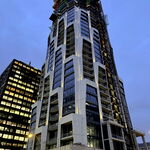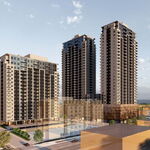Midtown Urbanist
Superstar
Yah, given how much dirt we are extracting from the ground at the moment, it'd be wise to use it for something practical instead of shipping it off to who knows where.
That who knows where is in Burlington.Yah, given how much dirt we are extracting from the ground at the moment, it'd be wise to use it for something practical instead of shipping it off to who knows where.
Yah, given how much dirt we are extracting from the ground at the moment, it'd be wise to use it for something practical instead of shipping it off to who knows where.
Yah, given how much dirt we are extracting from the ground at the moment, it'd be wise to use it for something practical instead of shipping it off to who knows where.
I still maintain that my 'bury the Gardiner along the front of the Harbour and create a waterfront park on top of it' is the best solution to a whole handful of problems. Solves the Gardiner situation, solves the fill situation, and solves the discontinuous waterfront situation. And unlike other Gardiner burial schemes, this one would pay for a lot of it itself, because of the reclaimed land for development from the old Gardiner site and the current waterfront slips that would become land-locked if a new park is placed further into the harbour.
I still maintain that my 'bury the Gardiner along the front of the Harbour and create a waterfront park on top of it' is the best solution to a whole handful of problems. Solves the Gardiner situation, solves the fill situation, and solves the discontinuous waterfront situation. And unlike other Gardiner burial schemes, this one would pay for a lot of it itself, because of the reclaimed land for development from the old Gardiner site and the current waterfront slips that would become land-locked if a new park is placed further into the harbour.
But the study was only for the East Gardiner.
That guaranteed that no complete solutions would be studied.

I think you might be underballing the cost/technical challenges of building an expressway and associated on/off ramps by the lake. It is highly unlikely that sale of the Gardiner lands (which is partly occupied by Lakeshore) will be sufficient for the project.
It might be a bit of a heresy coming from me, but I think the best option for the central portion is probably rebuild and rationalizing the on/off ramp system.
AoD
Although preferring a conventional-subway DRL, I thought of how John Tory's Smarttrack plan can be "fixed" and implemented.
The central section is all in tunnel; presumably under Wellington. This should sustain 3 branches, with combined headways of 5 min (15 min per branch), or even 3 min 20 s ec (10 min per branch).
The East York - Don Mills branch runs in a tunnel all the way to the northern end of Pape, then on a bridge over Don Valley, and elevated or tunneled in Overlea area. (I avoided the southern section of Bala sub, because it is very difficult to connect to BD subway, and because of the flood risks.) Being in the tunnel, this branch can have several useful stations in East Toronto and East York. North of Overlea, the line joins CP tracks, then splits north on a bridge parallel to DVP, and joins to the Bala sub.
The Agincourt and Lakeshore East branches may need a few tunneled sections, but mostly run on surface.
The western branches are almost entirely on surface. For this map, I selected routes optimal for 416 (Lakeshore West, Airport, and CP track to Steeles and Islington. I realize that from the GTA network purpose, it may be better to run two branches into Brampton and Mississauga. Anyway, the exact route of the outer sections is not the main point here.

Very similar to what I had come up with, but I like some of the changes. A couple of curious omissions though:
1) No electrified service on the Milton line? Even in the form of a spur to Square One?
2) I like the Weston branch, but why not extend it to Highway 7 to have it end at another major transit line?
3) Ditto for the Lakeshore and Stouffville corridors. To me, they seem to end a station or two short of their natural terminus points: Port Credit or Clarkson in the west (since Port Credit is pretty tight for a terminus), Unionville in the northeast, and Pickering in the east. I understand the "it's for Toronto" mentality, but it's curious that you extended it into the 905 for the Richmond Hill line, but none of the others.
Overall though, a very solid plan, and one that I agree with when it comes to how the DRL should take shape. The "relief" aspect of something like this is miles ahead of what any TTC subway within a reasonable budget could do.
Thanks for the comments!
True. If I could present a group of several maps, I would draw more lines particularly in Mississauga and Brampton. But on a single map, increase of the coverage area would make the central area less legit. Therefore, I decided to focus on the 416 services.
Richmond Hill Centre just happened to be lucky to be on the same map
This is not clear-cut. A rail based plan (with some tunnels) can certainly do more for the riders from outer sections of GTA, as well as those who travel long distances within GTA but not to the downtown core. However, it requires a consistent implementation, rather than small one piece at a time expansions. Otherwise, all modest incremental capacity increases will be consumed by increasing demand from 905, with nothing left to relief the Yonge line.
In contrast, a conventional-subway DRL project will certainly relief Yonge, even if expanded one piece at a time.




